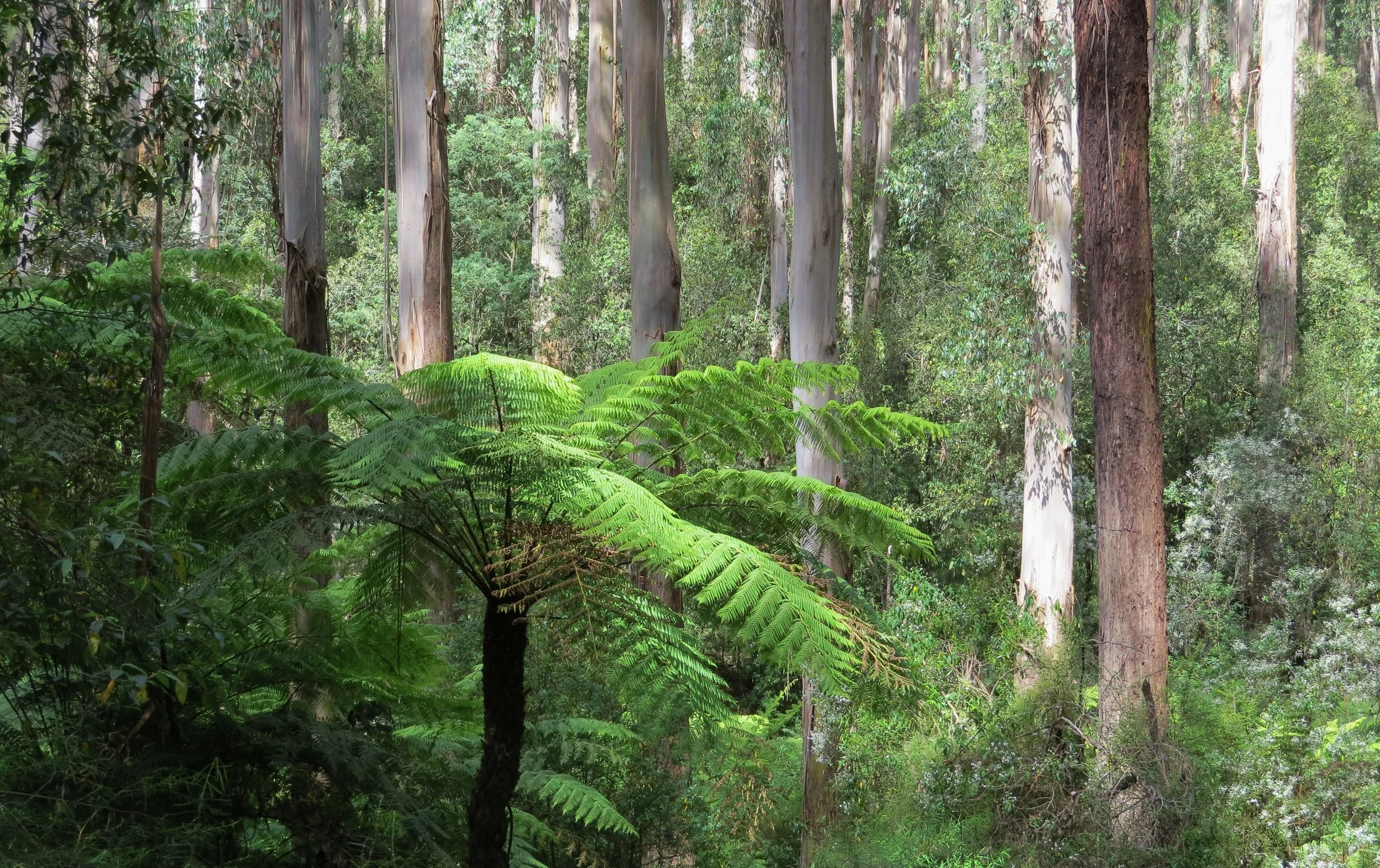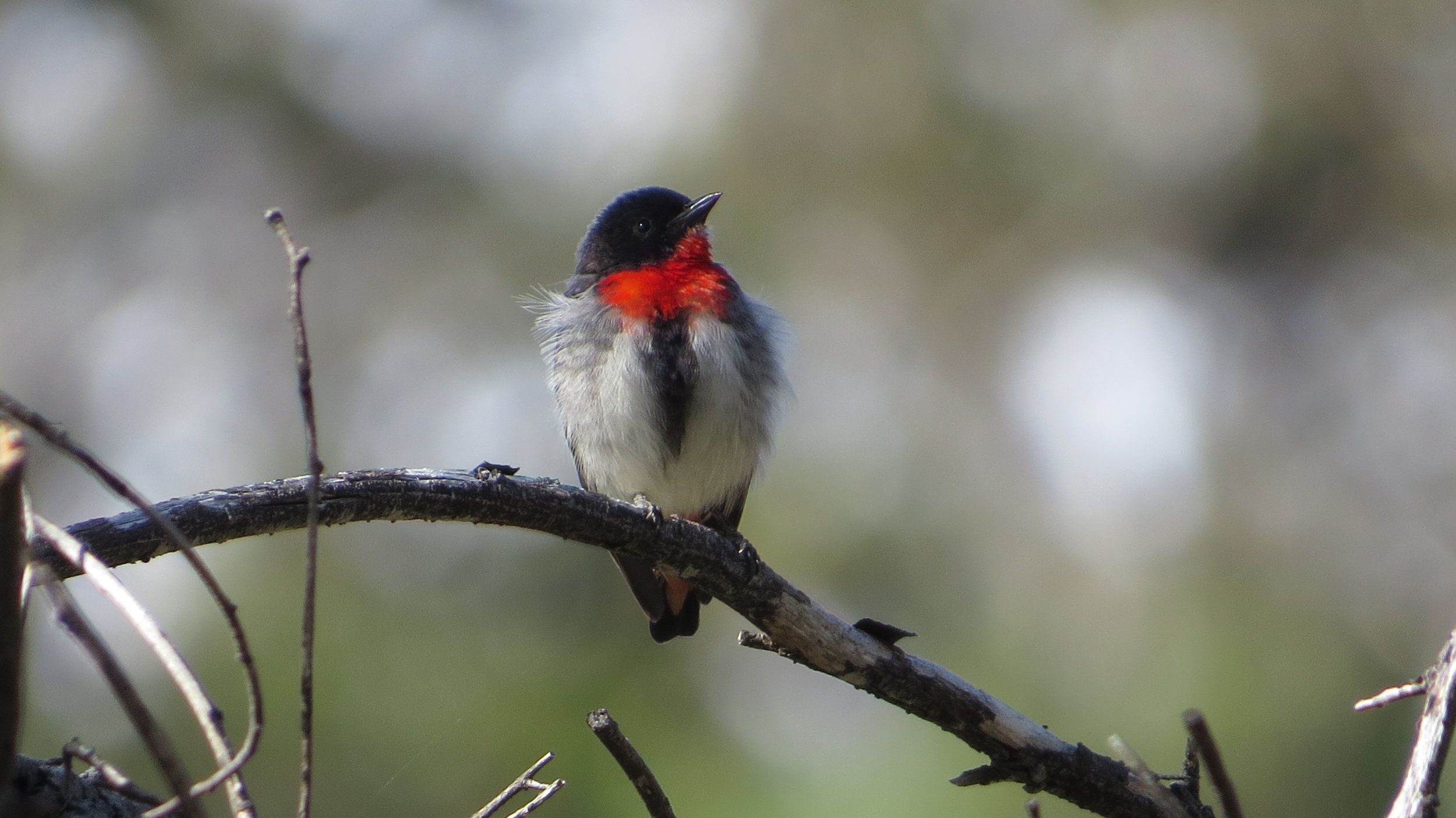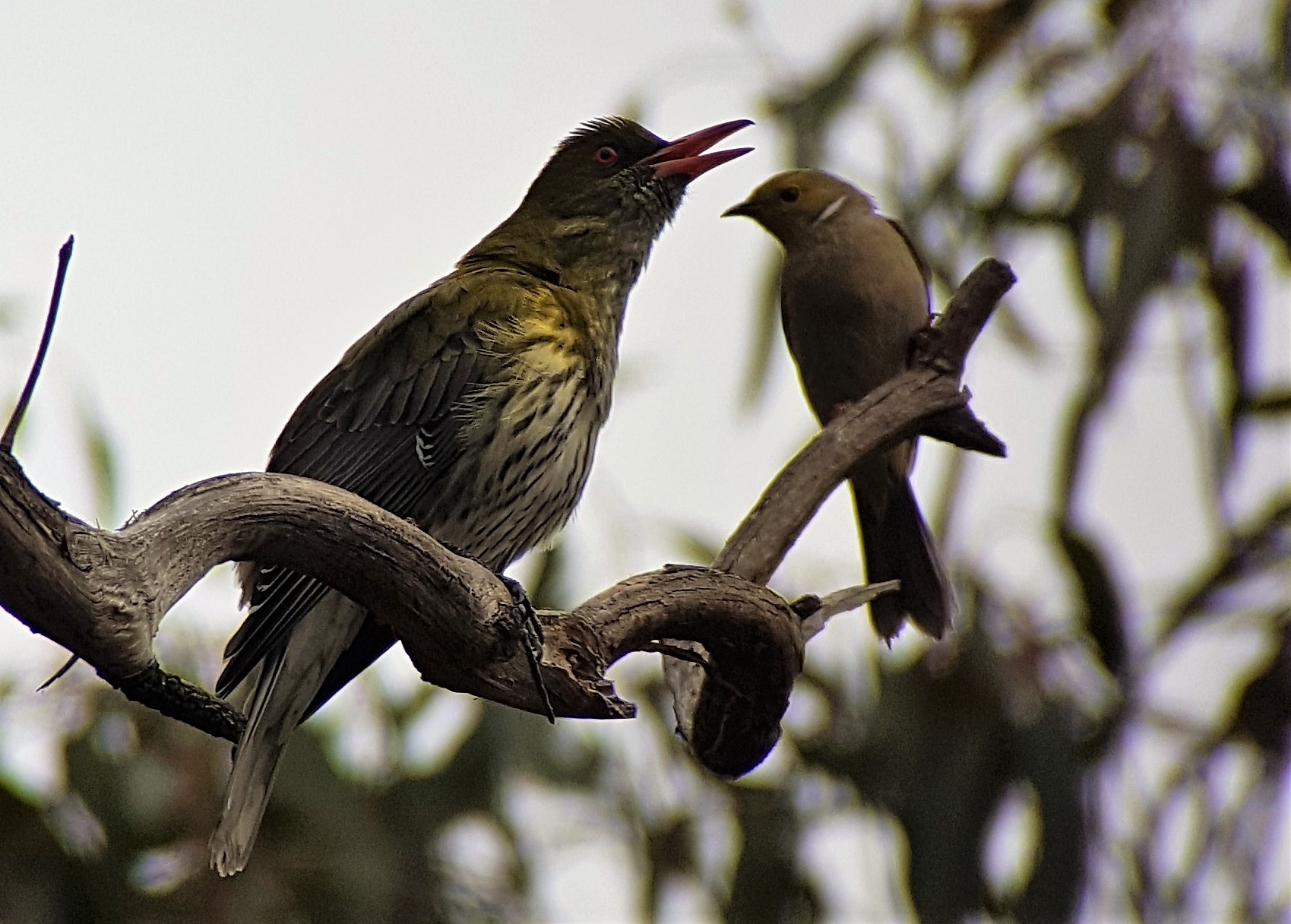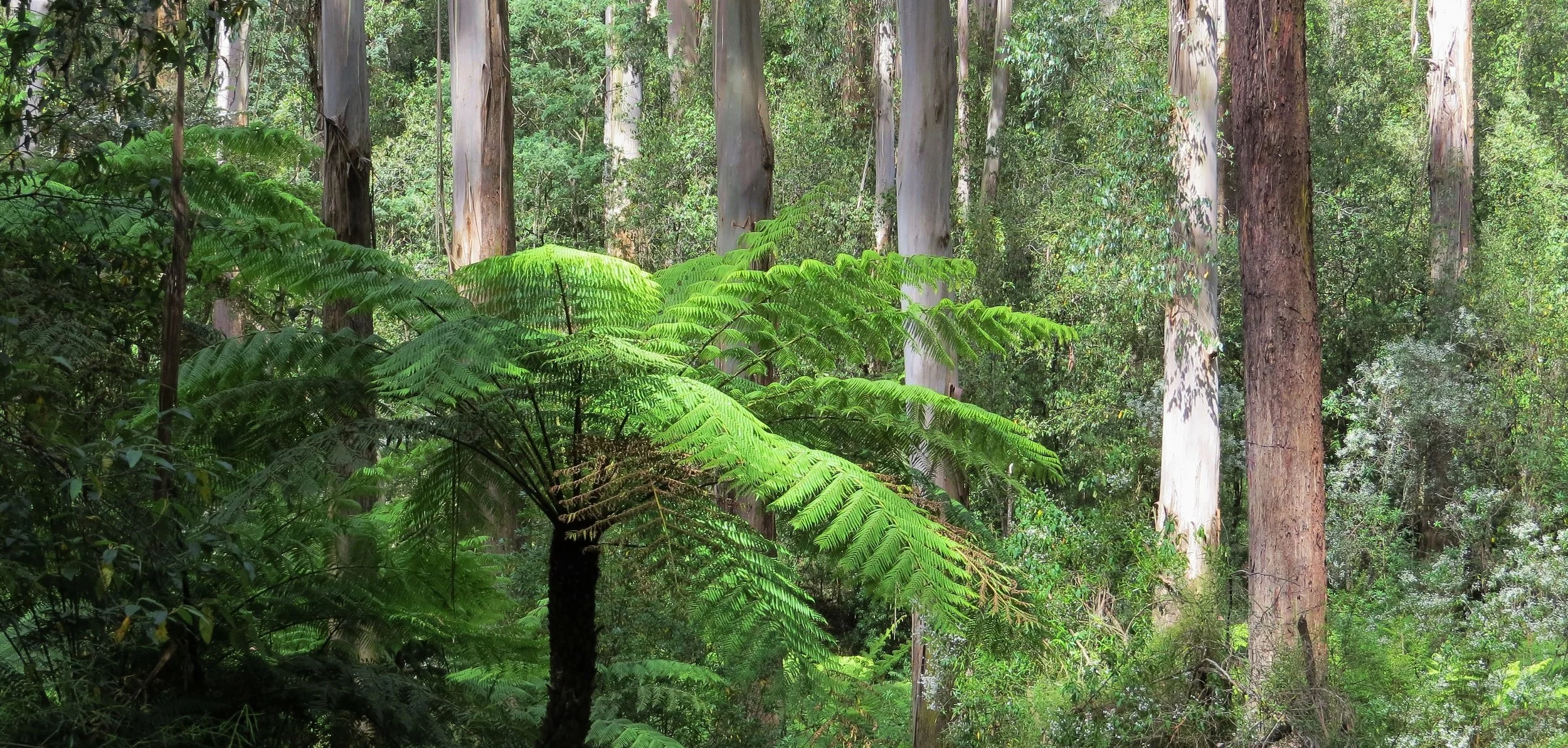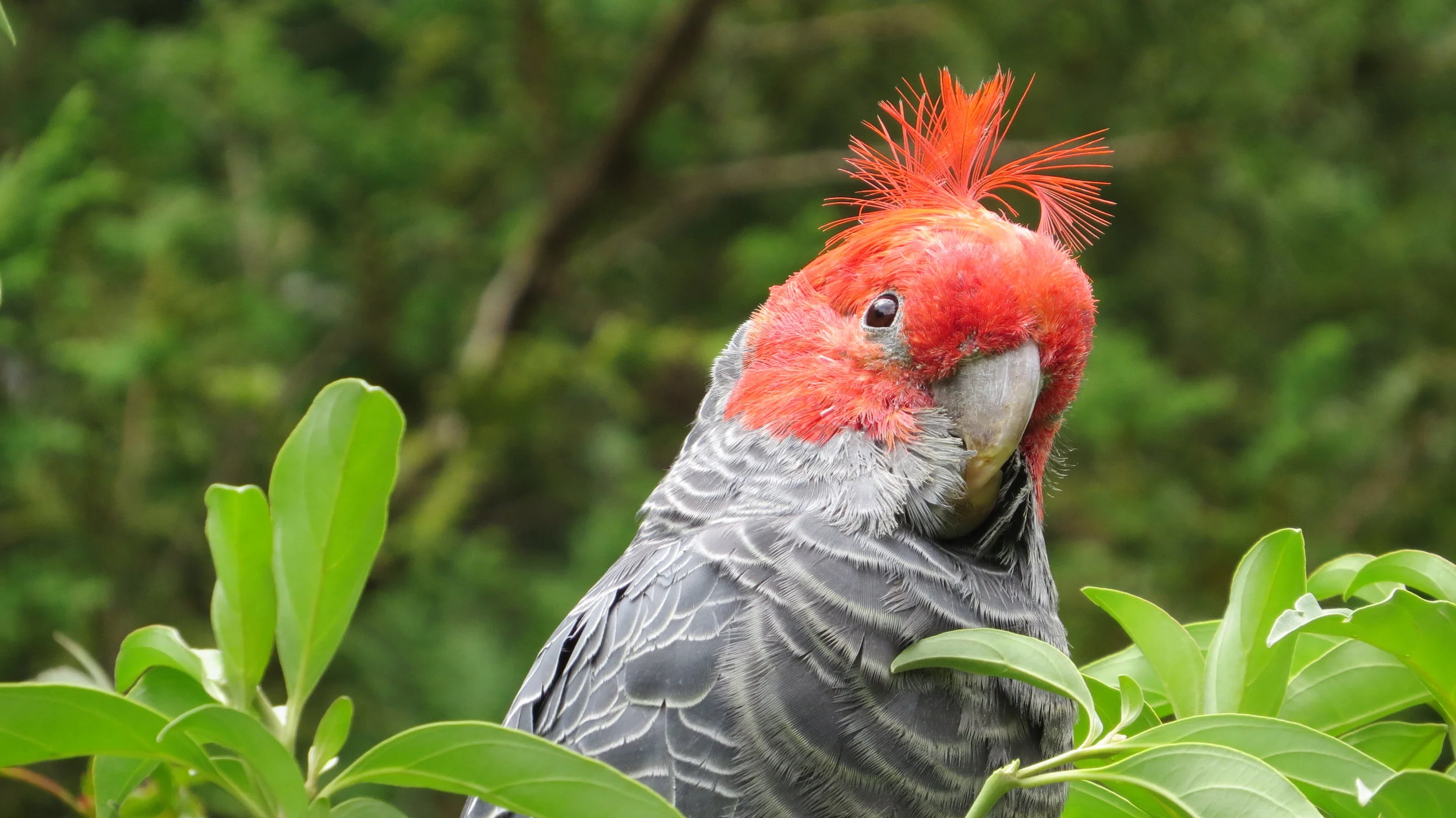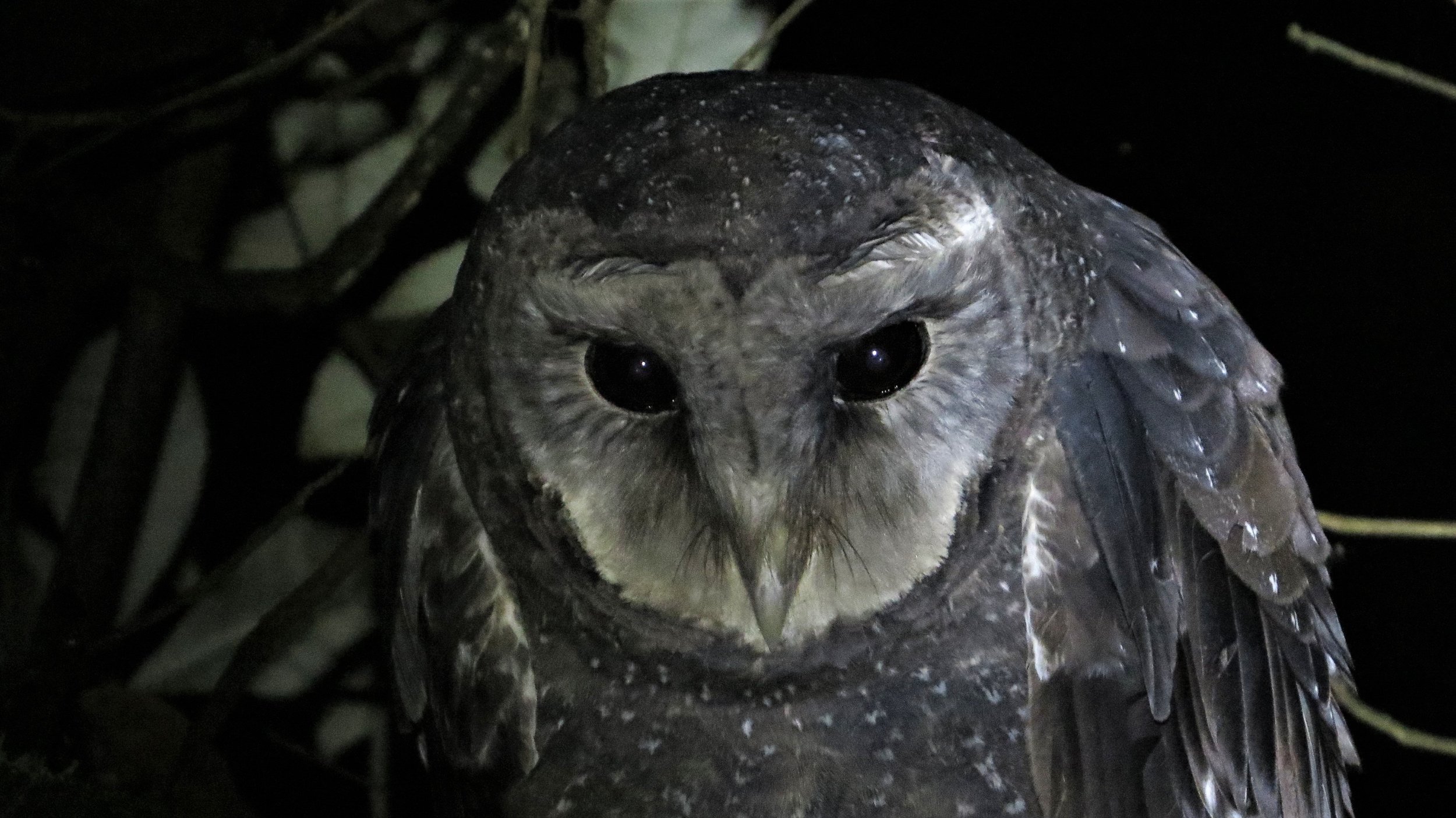REGION 1. MELBOURNE AND SURROUNDS
From open plains and wetlands in the west to mountain ranges in the east, the Melbourne region contains a diversity of landscapes, habitats and birdlife all within easy reach.
To the north and west of the city the landscape is part of the Volcanic plains ( see Western Victoria for more detail). To the North-east and East of Melbourne you are in the foothills of the Great Dividing range with its diversity of Eucalypt forests, including the towering Mountain Ash dominated highlands (see Gippsland section for more detail). And south-east of Melbourne you are in the Gippsland plains bioregion.
The Royal Melbourne Botanic Gardens
Situated in St Kilda, just 2kms from the CBD of Melbourne, the Royal Melbourne Botanical gardens were established in 1846 and cover 38 hectares. Easily accessed by tram or walking, this is a nice place to ease into Australian birds if you have just arrived in the country, and good at anytime for the world class plant collections.
The webpage at http://www.rbg.vic.gov.au/ has lots of information
Getting there: Walk or tram from Melbourne’s CBD.
Key sites: The main lake is home to a range of commoner native waterbirds. The plantings of various specimen trees attract a range of Parrots and Cockatoos and in recent years the Australian Koel has arrived in the spring. Denser areas provide refuge for smaller bird species, and the loud ringing call of the Bell Miner will give their presence away. The patient observer may spot a roosting Tawny Frogmouth and the Powerful Owl is an intermittent visitor.
Key Species: Nankeen Night Heron, Tawny Frogmouth, Australian Koel (spring or summer only), Bell Miner, Little Wattlebird, Song Thrush (occasional).
The Yarra River
The Yarra river winds its way from the Yarra Ranges to the east of Melbourne all the way into the heart of Melbourne’s CBD. For much of that length the surrounding land and vegetation is preserved for green space with only limited development allowed. As such it provides a green corridor allowing wildlife to move freely. There are many sites worth exploring along the way. Here are just a sample starting closest to the city.
Yarra Bend Park
This protects the largest portion of native vegetation adjacent to the city, whilst parklands and golf courses add to the attraction. A nice but short walk starts from the pipe bridge next to Fairfield park. This north-eastern section of the park contains very natural riverine vegetation. Just south of here, on the southern side of the Freeway and accessed off Yarra Boulevard is the Bellbird picnic ground. A spectacular colony of 1000's of Grey-headed Flying-Fox roost here during the day, certainly one of Melbourne’s most incredible wildlife spectacles. Footpaths follow the river frontage for nearly 16kms as well as alongside the Merri creek. Studley park in the south-west is a pleasant parkland with a variety of Parrots possible.
Key Species: Australasian Darter, Tawny Frogmouth, Azure Kingfisher (occasional), and Bell Miner. Up to 14 species of Parrot have been sighted here with 5 or 6 species present most of the time. A selection of smaller bush birds are recorded also, despite being lost from the surrounding suburbs.
Wilson Reserve
Accessed off The Boulevard in Ivanhoe, this reserve protects a dense pocket of riverine forest as well as temporary swamps and wetlands. It has a similar but more extensive bird list than Yarra Bend, particularly providing a home for a variety of smaller bush birds such as Eastern Yellow Robin, Superb Fairy wren, Red-browed Finch, Golden Whistler and Eastern Spinebill. Tawny Frogmouths are residents here also, and it falls with the territory of a pair of Powerful Owl which are around mostly in the summer months. Buff-banded rail occurs in the swampy areas, Bell Miners are in the nearby Chelsworth Park and a similar selection of Parrots.
Banyule Flats
Further upstream still, accessed from Somerset Drive off Banyule road, this park has much more extensive riverine woodlands and quite a large wetland area also. It is more regularly visited by birdwatchers and boasts a list over 150 species. A wide variety of waterbirds visit from time to time, and as the lake dries in summer Latham’s Snipe, and various Rails and Crakes appear. A small pond at the northern end of the large lake and ovals, called affectionately the Grotty Pond (it does tend to collect plastic bottles!) is a hotspot for Buff-banded Rail and Spotless Crake in season. A variety of raptors occur especially Brown Goshawk. Crested Shrike-tit, Mistletoebird and Olive-backed Oriole are all fairly regular, Flame and Scarlet Robins turn up in winter, Tawny Frogmouths and Powerful Owls are in the area much of the year, whilst Yellow-tailed Black Cockatoos, Gang Gang Cockatoos and Australian King Parrots are all regularly sighted especially in autumn and winter.
Warrandyte State Park
This state park protects significant stretches of land adjacent to the Yarra river on the outskirts of Melbourne in a more rural setting. From Templestowe to Eltham and Warrandyte and out as far as Wonga Park and Bend of Islands, some sites are easy to access, others very difficult involving walking trails or long drives along country tracks. Quality remnant vegetation here is known for its terrestrial orchid displays particularly in spring. Koalas Wombats and Platypus live here, as do Powerful Owls. Some popular sites to check include Pound Bend, Jumping creek reserve and Blue Tongue Bend, and the Heritage wetlands at Wonga Park (just outside the state park).
Woodlands Historic Park
Woodlands Historic Park is a one of the best examples Red Gum grassy woodland remaining close to Melbourne. There are a number of access points from which it is easy walking through grassland with large numbers of Eastern Grey Kangaroos, and open woodland with many old growth trees. Birding at any time of year can be worthwhile.
Getting there: This site is just 22kms from the city, and right next to Melbourne’s Tullamarine airport. Drive up the Tullamarine freeway and on past the airport then turn right onto Oaklands road. Either park at the Living Legends equine centre or further around on Somerton Road.
Key sites: From the car park on Somerton road walk into the woodland where a wide range of bush birds may be observed. A small creek and wetlands add to the diversity. If parked at the Homestead on Oaklands road walk south-east through open grassland down to some billabongs or into an area called “the back paddock” which is fenced and has a reintroduced population of Eastern Barred Bandicoots.
Key Species: Brown Goshawk, four species of Cuckoo in season, Tawny Frogmouth, Parrots and Lorikeets, Speckled Warbler ( rare, try the southern section of Back Paddock), Scarlet Robin (mostly autumn/winter), Red-capped Robin, and Flame Robin (autumn/winter)
The Dandenong Creek
Running through the eastern suburbs of Melbourne this creek is managed by Melbourne Water as a green corridor with sections of remnant floodplain forests and wetlands, some of which are newly created. The creek runs out of the Dandenong Ranges National Park flowing west and south.
The first site of significant interest is Liverpool Road Retarding Basin in Kilsyth South. Parking is on Liverpool road and the main attraction is the wetland along the northern boundary of the reserve especially the eastern sections where reedbeds and swampy grasslands are a home for Latham’s Snipe (summer). Any of the locally occurring Rails and Crakes may be observed, especially in summer when water levels may be lower. A vagrant Tawny Grassbird has been seen here a few times., The surrounding parklands hold a ranges of bush birds, and many parrot species pass through including Gang-gang Cockatoo, King Parrot and Yellow-tailed Black-cockatoo.
The next area of note is Koomba Park in Wantirna. Either park near the Wantirna Reserve in the south or at the small parking area in the north on Boronia Road. The Dandenong Creek shared Bicycle path provides access right through and various walking tracks allow further access including along the powerlines firebreak. Some swampy wetlands in the heart of the reserve hold a few waterbirds, surrounded by extensive swamp paperbark scrub. Taller riverine eucalypts closer to the creek are harder to access. Unlike the surrounding suburban landscape, Noisy Miners have not taken over this area which supports plenty of smaller bush birds. Sacred Kingfishers and Mistletoebirds are regular in summer. Bell Miners occur to the south and both Scarlet and Flame Robin may occur in winter.
Bushy Park wetlands are the next site downstream, park just off High St Road near the Pony Club and walk north. Open paddocks and rough grasslands plus a nice little wetland with a decent bird hide are all interesting. Various waterbirds pass through the area, whilst Lathams Snipe and various Rails and Crakes are all possible.
On the south side of High St Road the creek runs through the popular Shepherds Bush. Various access points include Napier Park, and the end of Shepherd Road. This reserve contains excellent quality riverine woodland with plenty of old growth trees plus paperbark swamps and adjoining woodland on the slopes, but no larger open wetland areas. A good selection of walking tracks provide excellent access. The reserve has quite a decent bird list with 126 species on eBird and is known for its Powerful Owls which are present for most of the year. They have many roosting sites usually using the paperbarks or wattles. Tawny Frogmouths occur year round, a wide range of Parrots pass through, and amongst the wide range of bush birds that frequent the area, scarcer species have occurred in season such as Rose Robin, Bassian Thrush, Rufous Fantail and Brown Gerygone.
Continuing south, the creek that keeps on giving next passes by Jells Park. Some open parklands and a large “wildlife” lake here is very popular for family picnics and a walk right around the lake takes you though some quite extensive woodlands. 144 species are listed on eBird for the site including visits by Freckled and Blue-billed Ducks occasionally, resident Australasian Darters, Cattle Egrets and Night Herons, Cuckoos in the spring and a nice range of Parrots and Cockatoos.
Next the excellent Dandenong Valley Wetlands are a huge area of open lakes and swamps developed by Melbourne Water recently for flood mitigation and water quality improvement. Access from Mulgrave reserve off Garnett road, walk north and then take the bridge across the creek. Although relatively new, these wetlands are already attracting many waterbirds, with sightings of Crakes, Wood Sandpiper each summer and Australasian Bittern more in winter. Water levels fluctuate throughout the year depending on how recent the rainfall has been. Various Dotterels and Sandpipers use the area when levels drop, Intermediate Egret has occurred here, and no doubt more good sightings will be had as the ecology of the site establishes. The forest along the creek itself holds a variety of bush birds with Song Thrush occurring here and Flame Robins are regular in the open areas in winter. Being quite extensive allow 2 or 3 hours to walk right around.
Finally the Heatherton Road Retarding Basin is a smaller area of wetland serving a similar purpose to the DVWetlands. Access off Heatherton road in Dandenong. It is a pleasant site with a nice mix of the commoner wetland and bush birds. Latham’s Snipe can occur in summer.
The Western Treatment Plant (or just “Werribee” to the locals)
Managed by Melbourne Water and accessible by permit only, the Western Treatment Plant (WTP) near Werribee, 50 kms west of Melbourne, is one of Australia's most famous birding sites. Situated on Port Phillip Bay, the treatment works features approximately 10,000 hectares of wetland and farmland, parts of which are managed specifically for wildlife. The diversity and sheer number of birds make this a very special place. In the warmer months over 100 species is quite possible in one day.
Getting there: Access is via the Point Wilson road if coming from Melbourne. If driving from Geelong turn off the freeway on to Beach road which goes past Avalon airport and then intersects with Pt. Wilson road. Without a key to access the plant, there is only limited viewing of wetlands along the Pt. Wilson road and also from near the boat ramp at the end of Beach road. A drive west from the boat ramp on a rough dirt track takes you to Kirk Point which is a roost for some terns and waders. Otherwise it is necessary to obtain a permit from Melbourne Water. Full details can be found at the Melbourne water website.
In this age of litigation we are very lucky to have access to such a permit system, and being a hazardous workplace it is very important all visitors register their visit and adhere to terms and conditions of the permit.
If you are visiting Melbourne for a short time, the permit system may not be practical, however if you are around for a few days it can be worth the effort. A general permit allows access to around half the wetland area, for full access undertaking an OHS induction is also required.
Key sites: The wetlands are very dynamic, with conditions changing all the time, depending on season, tide and water levels which are regulated by Melbourne water. At low tide many waders are to be found on the mudflats of the bay. At high tide they roost on rocky points along the coast as well as in various ponds depending on water levels. The Western lagoons are quick to get to off the bitumen and have waders, terns, Spoonbills, Egrets and lots more. From these lagoons drive along the track along the side of The Spit nature reserve, an area of saltmarsh, mudflats and shingle spits where coastal waders may be seen. The saltmarsh habitat has Australian Crakes, Buff-banded Rails and Lewin’s Rails. Look for gaps in the vegetation where there is bare mud exposed. The T-Section lagoons also hold waders. Reedy areas can be good for Crakes including the Baillon’s. The larger wetland to the north has regular Red-necked Avocets, and sometimes Cape Barren Goose. The other quick and easy area to access is to drive the loop which starts further north along Beach road onto Paradise road, past Paradise ponds ( also often good for Cape Barrens), and onto the Little River. Then follow the Little river to the coast where a bird hide is good at low tide when many waders can be seen. The saltmarsh here also has Rails and Crakes. Driving back to Beach road can take you past Lake Borrie and surrounds where thousands of duck are likely to be seen. The pond just inside the gate, at the boat ramp on Beach road is reliable for waders and birders often pick up rarities here.
Grasslands all around are excellent for raptors with most Victorian species present at times. Also Banded Lapwing, Brolga, Brown and Stubble Quail, and Zebra finch too. The road up to Ryan’s swamp is a good one for these open country birds as are the areas north and west of the Austin road lagoons.
Key Species: Blue-billed Duck, Freckled Duck, Cape Barren Goose, Black Falcon, Brolga, all of Victoria’s Rails and Crakes, waders including annual visits by Pectoral Sandpiper, Wood Sandpiper and Long-toed Stint, Banded Stilt, Little, Fairy and White-winged Black Terns amongst others, Blue-winged Parrot, Striated Fieldwren, Zebra Finch, rarities.
Brisbane Ranges National Park and the You Yangs Regional Park
These low ranges west of Melbourne have generally poor soils and lie in a rain shadow area. They are both excellent areas to become acquainted with a wide range of open woodland birds. The granite hills of the You Yangs have seen significant changes since European settlement, whilst the weathered soils of the Brisbane ranges have experienced recent extensive wildfires, however both regions still support good bird diversity.
Getting there: The main entrance to the You Yangs is along Forest road north of Lara. It is also possible to access quieter parts of the park in the east along Toynes road and Drysdale road.
The Brisbane ranges, a little further to the north-west has many access points, the main ones being just north of Anakie. There is no convenient public transport to either area.
Key sites : You Yangs Regional Park: Near the southern entrance and visitors centre has Yellow Gum woodland, particularly good in winter and spring when in flower. The Great Circle Drive takes you through a range of woodland types and has most of the parks bird species. Walking down to Hovell’s creek from Sandy creek road can be worthwhile, with Rainbow Bee-eater present in summer. Walking along Branding Yard road from the end of Toynes road is also excellent.
The Brisbane Ranges NP: Birding throughout the park can be worthwhile, with some better known sites including Anakie gorge which can be accessed in the east from The Gorge road or from the west at Stony Creek picnic ground on Switch road. Various sites along the Durdidwarrah-Steiglitz road are quite birdy and Steiglitz itself is a good area with a more open woodland of larger trees. Also worth driving are Aeroplane, Thompsons and Reids road in the northern plateau area where Spotted Quail-thrush is a real chance.
Some tracks are steep and rocky and may be unsuitable for small cars.
Key Species: You Yangs: Tawny Frogmouth, Diamond Firetail, Scarlet Robin, Woodswallows, Wedge-tailed Eagle, Rainbow Bee-eater, Cuckoos.
Brisbane Ranges: Spotted Quail-thrush, White-throated Nightjar, Scarlet Robin, Diamond Firetail, Chestnut-rumped Heathwren, Painted Button-quail, Yellow-tufted Honeyeater.
Driving through this region, roadside flowering trees attract good numbers of Lorikeets, in fact it is as good as anywhere in the state for seeing the small and beautiful Purple-crowned Lorikeet.
Serendip Sanctuary
This small oasis is well set out with walking tracks, contains grasslands, wetlands and woodlands and has a high species list for a relatively small area. Re-introductions of Magpie Geese and Cape Barren Geese have been successful, whilst the resident Emus are not yetconsidered to be naturalised. There are also some aviaries, however it is the abundance and diversity of wild birds that makes this area well worth visiting.
Getting there: A short drive north from Lara, with good signposting.
Key sites: Woodland around the car park often has Honeyeaters and Lorikeets. Many waterbirds use Lake Serendip, which can dry up in late summer. Smaller wetlands in the northern parts of the reserve are also excellent especially the far north-east corner where there is a bird hide amongst some lignum wetlands.
Key Species: Cape Barren Goose, Magpie Goose, Tawny Frogmouth, Black-chinned Honeyeater, Crested Shrike-tit, Purple-crowned Lorikeet, Australian Crake, Black-tailed Nativehen, Little Eagle.
Edithvale Seaford Wetlands and Braeside Park
South-east of Melbourne there was once a huge wetland (Carrum Carrum swamp), which is now much reduced but what remains is still of national significance. Surrounded by suburbia and only a km or so from Port Phillip bay, the Edithvale wetlands are well worth a visit especially later in summer when water levels drop and migratory waders increase.
Braeside park includes areas of Red Gum grassy woodland, heathland and wetlands, and nicely complements a visit to Edithvale. Again the wetlands are at their most exciting in late summer as the water levels drop.
Getting there: Edithvale wetlands can be reached on foot to from Edithvale train station. Just walk inland away from the beach for one and a half kms along Edithvale road.
Braeside park is just a few kms north of Edithvale and is best accessed from the southern end off Governor road. Be aware that the gates here are locked around 4pm.
Key sites: Some of the best viewing is to be had along Edithvale road itself which dissects the wetland. There is a small bird hide looking south, next to the road, and a larger information centre which only opens on Sat and Sun afternoons and also some Wednesday evenings in summer. More views can be had looking through the fence that runs down the eastern side.
This southern part of the swamp usually dries up in late summer.
Best access to the northern part of the swamp is through a gate on the western side, north of Edithvale road. There are walking tracks right the way around the area. This part of the wetland holds water more permanently.
Key Species: Australasian Bittern, Black-backed Bittern, large numbers of Sharp-tailed Sandpiper in season, Wood Sandpiper, Magpie Goose, Swamp Harrier, rails and crakes.
Dandenong Ranges National Park
Sherbrooke Forest
Located on the eastern outskirts of Melbourne the Dandenong Ranges are a quick and easy mountain escape from busy Melbourne. There are several separate sections of forest with the most interesting areas for birds being the tall wet forests of Mountain Ash, and the damp gullies with an understory of giant tree ferns. There is a healthy population of Superb Lyrebirds in these ranges, thanks to conservation works and control of feral animals.
Getting there: It is possible to walk from Upper Ferntree Gully or Belgrave train stations. The drive is around 40 kms from Melbourne’s centre.
Key sites: Sherbrooke forest is the largest section of the park, and has plenty of Mountain Ash, tree ferns and Lyrebirds. Both the Sherbrooke and O’Donahue’s picnic grounds are a great place to start, with trails taking you down through the forest to Sherbrooke falls. The Lyrebird walk and Neumanns track accessed from Grants picnic ground are also excellent trails to look for Lyrebirds.
The Ferntree Gully section of the National Park also contains some excellent wet forest, with the Tree Fern Gully track being good, but be aware it is now also a monument to Kokoda, and on weekends and holidays literally hundreds of people do the climb. The stunted forest on the steep western slopes of Ferntree Gully are quite different to the sheltered gullies, and allow some closer views of small bush birds.
Key Species: Superb Lyrebird, Red-browed Treecreeper, Crescent and Lewin’s Honeyeaters, Yellow-tailed Black Cockatoo, Australian King Parrot, Olive Whistler, Pilotbird (rare), Rose Robin, Rufous Fantail, Bassian Thrush.
Photo by Steven James
Yarra Ranges National Park and Toolangi state forest
Drive a little further out of Melbourne to the east, and you will reach the more extensive natural areas of the Great Dividing range. The Yarra Ranges NP protects Melbourne’s water catchment, supplying the city with some of the cleanest water of anywhere in the world. The most accessible birding areas are accessed from Healesville or Warburton, both towns surrounded by lush forests and towering mountains. With the connectivity of habitat all the way from here to Gippsland, these parks and their varied forests provide opportunities to find a wide range of species, including many that are at the edge of their Australian range.
Getting there: Both Healesville and Warburton are around one and a half hours drive out of Melbourne. Take the Maroondah highway out past Lilydale, after which you may turn right to Warburton or continue on to Healesville.
Key sites: Mt Donna Buang is a drive up the mountain from Warburton. The narrow road has many passing points which provide the opportunity to park and do some spot birding. The road continues on over the mountains right through to Healesville, but some sections are closed in the winter. It is passable in 2WD but care should be taken in wet weather as one section is unsealed. At the rainforest canopy walk you can experience a Myrtle Beech forest. The drive from there through to the 10 mile picnic ground provides some of the best birding, and is particularly good for Olive Whistler, Pink Robin, Pilotbird and Superb Lyrebird. The birding is challenging due to the dense habitat and tall trees, and can be very quiet in winter.
Badgers Weir just south of Healesville has some easy walks, is a good place to look for Superb Lyrebird, and is worth trying some spotlighting after dark, however be aware that the gate is locked so walking in is required in the evening. Donnelleys Weir just north of Healesville is also well worth a visit for species such as Red-browed Treecreeper and Gang Gang Cockatoo.
Further north from Healesville, Toolangi state forest has some protected areas with good quality rainforest. The best of these for access is the Wirrawalla rainforest walk on Sylvia creek road. A boardwalk takes you into the cool temperate rainforest of Myrtle Beech. Quarry road, which is really just a track, is a great walk from the car park, taking you further on alongside Sylvia creek. The Myrtle Gully walk is also excellent, starting from the Myrtle Gully car park in the north and connecting with the Wirrawalla walk in the south.
Beware of logging trucks around Toolangi, they don’t always slow down.
Key Species: Sooty Owl, Powerful Owl, Superb Lyrebird, Pilotbird, Olive Whistler, Pink Robin, Rose Robin, Crescent Honeyeater, Lewin’s Honeyeater, Large-billed Scrubwren, Eastern Whipbird, Bassian Thrush, Gang Gang Cockatoo, Eastern Whipbird.
Bunyip State Park
Another large area of forest well worth the day trip from Melbourne is Bunyip State Park. One of Bunyip’s main attractions is the greater diversity of habitats, including wet and dry scleophyll forest, heathy woodland and swampy heathland. Much of the eastern section of the park is recovering from wildfire. Weekends and holidays attract many trail-bikes to the park, but it is generally a big enough area to not become a major issue.
Getting there: The two most convenient entry points to the park are from Gembrook in the west (via Belgrave and Emerald) or from Tynong north in the south (via the Monash Freeway). The tracks in the park are mostly well maintained, but watch out for potholes.
Key sites: Birding throughout the park can be worthwhile, so stopping at signs of activity is the way to go. Along Camp road and the buttongrass walk are areas of heathy woodland with Southern Emu-wren and sometimes Beautiful Firetail. More of this habitat can be found along the Bunyip river road. Diamond creek runs east west through the park and attracts Sacred Kingfisher, Red-browed Treecreeper, Gang Gang Cockatoo, Eastern Whipbird and Satin Flycatcher amongst others. Link road climbs up to a higher altitude and passes through some wet forest with Superb Lyrebird, Pilotbird, Rose Robin, Rufous Fantail all regular. Dyers picnic ground is a great site with Satin Bowerbird, Satin Flycatcher, Rose Robin and a chance of a Koala. The first section of Ash Landing road follows alongside a wet gully with some good birding opportunities. Brown Gerygone and Black-faced Monarch are both possibilities.
Regrowth areas in the east, such as along Forest road have attracted Brush Bronzewing and Blue-winged Parrot as well as Pilotbird in the gullies. Night drives have much potential with Sooty and Powerful Owls sometimes seen plus many nocturnal mammals. The Helipad is a known stakeout at dusk for White-throated Nightjars in summer.
Tarago road in the Tarago state forest outside the park to the east is also a quality area for wet forest species.
Key Species: Southern Emu-wren, Beautiful Firetail, Superb Lyrebird, Rose Robin, Satin Flycatcher, Gang Gang cockatoo, Pilotbird, Sooty Owl, Lewins Honeyeater, Large-billed Scrubwren, Red-browed Treecreeper, Blue-winged Parrot, Scarlet Robin, Painted Button-quail.
